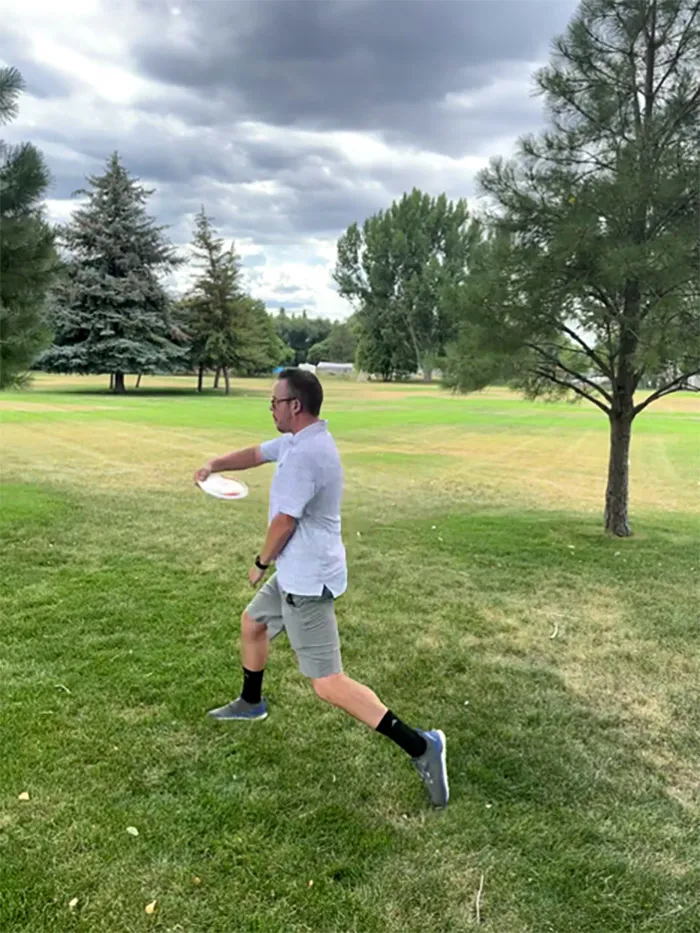Last updated on September 23rd, 2023 at 04:53 am
Last updated by Maredith Damasco
How to Throw a Disc Golf Flex Shot
Shot shaping
One of the amazing aspects of our sport is our ability to shape our shots. It is frequently a necessity. Course designers intentionally design holes that force us to carve around trees and obstacles. That makes disc golf fun and interesting. When we hit the lines right, the flight of the disc is a thing of beauty. One of the more impressive flights of a disc is the flex shot.
Disc Golf Terms
For a brief reminder of disc golf terminology, a flex shot is one where the player throws an overstable disc on an anhyzer angle, knowing that the disc will straighten out from the anhyzer line, then fade at the end of the shot. The flight line looks like an exaggerated ‘S’ line.
Here are a couple more quick definitions of disc golf terms used above:
Overstable
this is a discs ability to resist the natural tendency of a disc to turn in the opposite direction of spin at a high rate of speed. For a right-hand, back-hand throw, discs will turn to the right at high speed, then finish left at low speed (fade). Overstable discs resist the turn, and usually fade harder as they slow down.
Anhyzer (opposite of hyzer)
When you throw a disc at an angle with the right side angled down, it makes the disc fly… toward the right.
Turn
A discs propensity to turn to the right at high speeds. It is also the third number in the four-number flight rating.
Fade
A discs ability to resist turn at high speed, and how far it will travel to the left as it slows down. It is the fourth number in the four-number flight rating.
Release angle
When referring to a flex shot and hyzer or anhyzer angles, I am referring to the left-to-right angle of the disc at the point of release. The front-to-back angle at the point of release is called the nose angle.
Throwing a Flex Shot

Adding the flex shot to a disc golfer’s repertoire provides an extra approach to navigate fairway obstacles, as the disc’s predictable right turn followed by a dependable ‘flex’ back allows for numerous strategic paths around or through trees.
To successfully throw a flex shot, there are a couple of key factors:
- Disc selection
- Release angle
- Form (sufficient power and proper snap)
Pick the Right Disc
Disc selection: This is a situation where your disc choice is very important in the proper execution of the throw. Considering the need for the disc to dominate the anhyzer angle, opt for an overstable disc that suits your skill level. Furthermore, it’s evident that advanced players require significantly more overstable discs compared to those used by beginners. Nevertheless, selecting a disc that is excessively overstable can lead to a loss of both distance and the desired trajectory crucial for executing a flex shot. Too understable and the disc might never overcome the initial anhyzer angle and will crash to the right or end up as a roller.
Regular practice is crucial in honing the art of selecting the right disc with precision, particularly for challenging shots like the flex shot. Opting for a mildly less overstable disc elongates the anhyzer phase, resulting in the disc drifting farther right before settling and concluding with a left-hand fade. Conversely, a highly overstable disc will promptly straighten out and have a shorter flight duration. Developing the knowledge of which disc to choose can be acquired through practice in the field.
Find the Right Angle

Concerning the release angle, even when carefully selecting the right disc, your technique may still falter if the disc is released at an incorrect angle. Therefore, it’s essential to invest time in practicing disc angles and familiarizing yourself with the suitable release angle for the specific disc in use. Experimenting with various angles broadens your strategic options across different scenarios. Opting for a steeper release angle initiates increased anhyzer, leading to an extended rightward trajectory (in the case of a RHBH throw) before the disc’s inherent overstability kicks in, leveling its flight. Conversely, choosing a flatter release angle restricts the disc’s rightward movement before it stabilizes and begins to turn left. Either of those angles could be used, depending on the situation.
Use the Proper Form

Because executing a flex shot demands precision, it’s imperative to consistently uphold proper form. Furthermore, guaranteeing the disc’s flight, especially during the initial ‘anhyzer’ phase, necessitates generating substantial power and snap in your throw. In addition to this, mastery of the correct flex technique depends on managing both the nose angle and the throw’s elevation, which are two crucial elements.
Avoid excessive height on your flex shot to maintain energy and prevent premature exit from the anhyzer line. Flattening out your throw and keeping the nose angle down will help keep the disc fly flatter, and farther.
With a typical RHBH throw, we bend forward slightly at the waist during our pull. With a roller shot, we lean back slightly. When throwing a flex shot, our body will be anywhere from straight to slightly leaning back. Our exact position will depend on the angle of the flex shot. You want to get the angle that you need by bending at the waist, and not turning your wrist. If you try to get the angle with your wrist it will usually result in missing your line and not getting the power you need. With a forehand flex shot, you can change the angle of the wrist to achieve the proper disc angle.
Conclusion
Each of us should incorporate the flex shot into our disc golf arsenal as a powerful utility shot. Field practice is essential to master the form and understand disc flight on an anhyzer angle. Once we learn the flex shot, it is something we can use to expand our shot selection.

